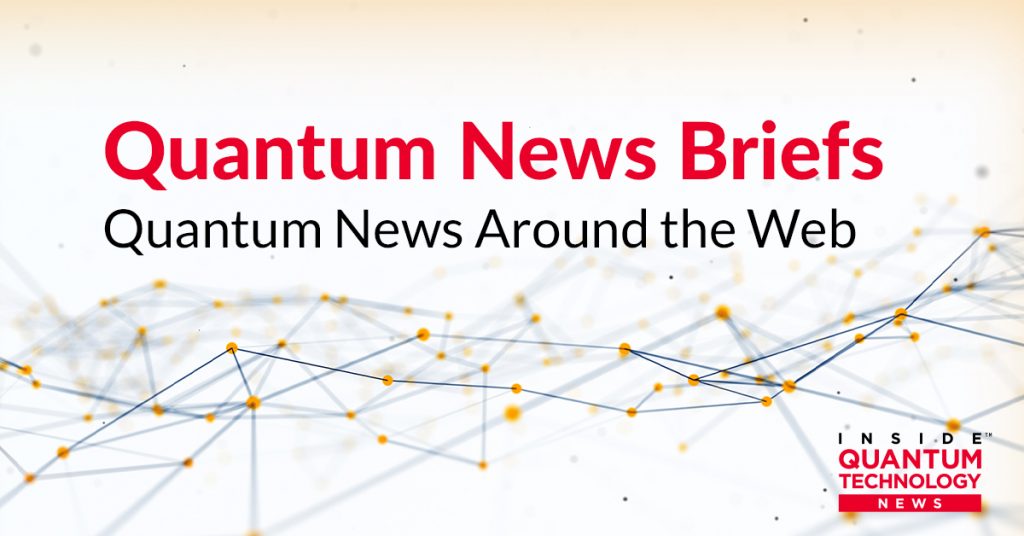In Quantum News Briefs today, we begin with the announcement of an open quantum telecommunications network from Canada’s Numana followed by information about the National Science Foundation’s new supplemental funding to cloud-based quantum computing. A future-looking brief about the role of quantum computing for autonomous vehicles is third and two MORE successful quantum tech research reports shared today: from JILA in Colorado and Japan’s University of Tsukuba.
Numana Announces the Launch of an Open Quantum Telecommunications Network
Through this project, the Quebec government intends to:
–Enable Quebec to develop its quantum communications and cybersecurity expertise and infrastructure on existing communications networks;
–Foster the emergence of a competitive industrial sector for quantum communications, including network components and service offerings, in Quebec;
–Promote the growth of the Quebec ecosystem by offering a prototyping platform open to all.
Numana is a catalyst for technological ecosystems. With partners, it brings innovative people together to create more value for the technology industry and for Quebec as a whole.
*****
NSF Announces Supplemental Funding Access to Cloud-Based Quantum Computing
The letter reads: “With this Dear Colleague Letter (DCL), NSF’s Directorate for Computer and Information Science and Engineering (CISE), the Directorate for Mathematical and Physical Sciences (MPS), the Directorate for Engineering (ENG), and the Directorate for Technology, Innovation and Partnerships (TIP) notify the research community of their intention to support supplemental funding requests for currently active NSF awards to enable use of these quantum-computing platforms. NSF’s supplemental funding will include support for graduate students as well as fees to work on these hardware and software quantum platforms. Click here to read the Dear Colleague Letter describing the funding.
Supplemental funding requests will be limited to research activities in the following research areas:
–Quantum algorithms and their experimental realization;
–Quantum compiler and run-time infrastructure design;
–Fault-tolerant computing and other methods to boost the performance of existing quantum-computing hardware;
–Benchmarking of architectures, systems, algorithms, and scalable error-correction techniques;
–Quantum simulations, optimizations, cryptography, and machine learning; and
–Demonstrations of feasibility for applications of quantum algorithms.
*****
How Can Quantum Computing Help Autonomous Vehicles?
Safety and Reliability: Quantum computing can solve the issues of the safety and reliability of autonomous vehicles.
Traffic Congestion: Quantum computing can help reduce traffic congestion by analyzing data from the sensors inside autonomous vehicles, thus ensuring route optimization.
Training to Algorithm: Quantum computing can be used to train algorithms while designing autonomous vehicles to enable better safety and fuel efficiency.
Research and Development: Quantum computing can also provide a boost to automotive players transitioning into the electric vehicle era by notably stimulating research and development of novel technologies.
Fuel Efficiency: Quantum computing can be used during vehicle design to produce various improvements such as minimizing drag and improving fuel efficiency.
*****
How to Handle Quantum Information Without Destroying It: Group’s Results Could Be Major Step Toward Quantum Internet
In the study, a team of physicists demonstrated that it could read out the signals from a type of qubit called a superconducting qubit using laser light—and without destroying the qubit at the same time.
The group’s results could be a major step toward building a quantum internet, the researchers say. Such a network would link up dozens or even hundreds of quantum chips, allowing engineers to solve problems that are beyond the reach of even the fastest supercomputers around today. They could also, theoretically, use a similar set of tools to send unbreakable codes over long distances.
“Currently, there’s no way to send quantum signals between distant superconducting processors like we send signals between two classical computers,” said Robert Delaney, lead author of the study and a former graduate student at JILA.
Diamonds for Quantum Sensing & Spintronic Quantum Computers
“With nonlinear opto-magnetic quantum sensing, it will be possible to measure local magnetic fields, or spin currents, in advanced materials with high spatial and temporal resolution,” senior author Muneaki Hase and his colleague Toshu An at the Japan Advanced Institute of Science and Technology, say. The team hopes that this work will help enable quantum spintronic computers that are sensitive spin states, not just electrical charge as with current computers. The research may also enable new experiments to observe dynamic changes in magnetic fields or possibly even single spins under realistic device-operating conditions.
Sandra K. Helsel, Ph.D. has been researching and reporting on frontier technologies since 1990. She has her Ph.D. from the University of Arizona.
